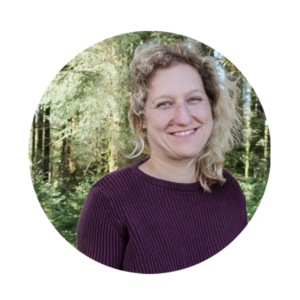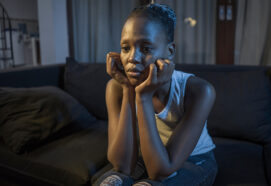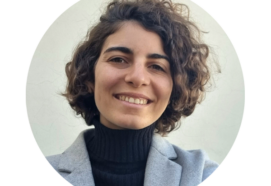In this podcast, Dr. Abigail Russell discusses suicide and self-harm with freelance journalist Jo Carlowe.
Abigail discusses her paper on inflammation and self-harm, its findings and implications moving forward. As well as the cohort study (ALSPAC), to school interventions and creating change through national dialogue.
You can listen to this podcast directly on our website or on the following platforms; SoundCloud, iTunes, Spotify, CastBox, Deezer, Google Podcasts and Radio.com (not available in the EU).
There is also a free lecture you can access, filmed at our conference to launch the JCPP Special Issue on Suicide and self-harm: Pathways for Minimizing Suicide & Premature Deaths and Maximizing Hope and Wellbeing.
Transcript
Interviewer: Hi, I’m Jo Carlowe, a freelance journalist with a specialism in psychology. Today, I’m talking to Dr. Abby Russell on behalf of ACAMH. Abby is a senior research associate in epidemiology at the Center of Academic Mental Health, University of Bristol Medical School. Hi, Abby. ACAMH has had great pleasure to cover your latest study on whether inflammation mediates the association between adverse childhood experiences and self-harm, not only in the JCPP special issue, but also in our magazine, The Bridge and of course, as part of our quiz on suicide and self-harm, sponsored by Wiley. This study looks directly at the mechanisms that might drive self-harming behaviours in adolescence. Can you tell us what led to the conception of this project and what your main aims are?
Dr. Abby Russell: Sure. Self-harm is, unfortunately, very common in young people, but we still have a poor understanding of what actually causes it. Most of the research on self-harm focuses on psychological risk factors, but we don’t have a lot of information on biological factors that might increase the chance that young people might self-harm. This is the area that we are researching. The research over the last 30 years, has shown that facing bad or adverse experiences early in life leads to people being at a higher risk of self-harm or attempting to end their life, but we don’t yet understand why this happens. What we do know is that early experiences can impact on the way the body works, changing hormones, influencing chemicals around our genes and activating the immune system, for example. These impacts on the body might increase our risk of self-harm. For example, by changing the levels of different neurotransmitters in the brain that impact on our mood. So, the main aims of our project are to explore whether these different biological processes explain the link between childhood adversity and later self-harm. By childhood adversity, I mean experiences like being abused or neglected, having parents with criminal convictions or witnessing domestic violence. This is the first study in a series of studies that’s going to explore this and we focus on inflammation or how activated a young person’s immune system is.
Interviewer: For those who have not yet had a chance to read your paper in detail, could you briefly explain the main take-home messages of your study and what your findings mean, going forward?
Dr. Abby Russell: Sure. So we looked at nine different types of adversity and we found that the more different types of adversity young people experience before the age of nine, the more likely they were to report that they self-harmed by the age of 16. Specifically, for every extra type of adversity, a young person was on average 11% more likely to report self-harm and 22% more likely to report self-harm with suicidal intent. So, what we then did was we measured how active children’s immune systems were by taking a blood sample when they were nine and a half years old and measuring the levels of two markers of inflammation. But we didn’t find any evidence of a link going from adversities through inflammation to self-harm and what this means is that activation of the immune system in children is not likely to be a useful indicator of whether they may self-harm later on. We need to look at other biological and psychological pathways. It’s important to do this because many people experience adversity in childhood. So, if we can understand how this increases our risk of self-harm, we might be able to develop ways to prevent these negative outcomes from happening.
Interviewer: Great, thank you. Your study used data from the world leading birth cohort study, the Avon Longitudinal Study of Parents and Children. Could you tell us a little about ALSPAC and how its establishment has advanced our understanding on the drivers of self-harm and suicide in adolescents?
Dr. Abby Russell: Yeah. ALSPAC is a study that’s followed up a large group of people over time. The young people in ALSPAC were all born in the area of Bristol and Avon in 1991 and 1992. So, originally over 14,000 pregnant women were recruited to take part and then researchers have followed up the women and their child over the last 28 years. Roughly once a year these mothers and their partners and then, the young people have filled in questionnaires or visited research clinics so that we’re able to collect information about all aspects of their lifestyle, their education and their health. What that’s allowed us to do is build up a really detailed picture of how children develop in different ways and factors that might impact on their well-being. So, in the case of self-harm, we can look at young people who do and do not have a history of self-harm, which we asked them about when they were 16 years old, and then look back to see if they had other biological or psychological factors in common when they were growing up.
Then, the second part of your question, thinking about how this has advanced our understanding of the drivers of self-harm and suicidal behaviour. The studies that our group have conducted in Bristol cover a wide range of topics and we’ve published over 20 papers on self-harm using our study data. So, for example, one study that looked at transition from suicidal thoughts and non-suicidal self-harm, to suicide attempts found that most adolescents who think about suicide or engaging non-suicidal self-harm will not make an attempt on their life. But asking about substance use, self-harm, sleep and exposure to self-harm in others, could help us to identify which adolescents are at the greatest risk of attempting suicide in the future.
Interviewer: What else would it look at, going forward?
Dr. Abby Russell: So, going forward, we’re continuing to follow these young people up. So, now they’re in their late 20s, but also, a lot of them now have children of their own and they’ve been recruited take part as well so we can follow up what happens to their children.
Interviewer: We understand that one of your research interests is exploring self-harm and suicide prevention and intervention methods in schools. In your opinion, what are the main barriers and facilitators to implementing strategies to address self-harm and suicide in schools?
Dr. Abby Russell: This is an interesting question. So, a couple of years ago, I was involved in a project that was a collaboration between five different universities. So, Exeter, Bristol, Bath, Cardiff and Swansea and we explored what secondary schools are doing in terms of prevention and intervention for self-harm. So, we did a survey of 222 schools in Wales and South West England and we did in-depth focus groups with staff at eight schools. And what we found was that the main barriers was the lack of staff training around self-harm and suicide, which meant that staff had a lack of knowledge and they were anxious about talking about self-harm. I think, for people who are trained clinicians or who work in the area of self-harm, sometimes it’s easy to forget just how shocking it can be for teachers if a young person comes to them to disclose that they self-harmed or they’re having suicidal thoughts. Schools are terrified of doing or saying the wrong thing and this can mean that they’re not willing to talk specifically about self-harm or suicide with their students. So, I think we need better training for staff in mental health and more resources to help them work with young people who self-harm, that might help overcome this barrier.
The other thing that we know is that self-harm can cluster in schools and schools are very worried about the potential of contagion or triggering other students to self-harm if they talk about it openly. This is a huge barrier to doing activities around prevention of self-harm because it needs a careful balance between not stigmatising young people who self-harm and not giving other vulnerable students ideas. But what schools do do is promote awareness around mental health and wellbeing and promote positive coping strategies that young people can use when they’re facing stressful situations.
Interviewer: Right. This idea of contagion. Is that something that has been proven to exist?
Dr. Abby Russell: It’s a very difficult topic, contagion. There is evidence that young people who know others who have self-harmed may be more likely to self-harm, themselves, but the longer-term impacts of this aren’t well understood. Actually, I think the evidence now is suggesting that it’s better to talk about these things in order to raise awareness and prevent them than to just sweep them under the carpet. I think historically, a similar thing happened with suicide where people used to not want to talk about suicide or mention it because they were worried that would lead to more people dying by suicide. Over the last three or four decades, we’ve understood that actually, in order to prevent something occurring, you do have to talk about it.
Interviewer: Yeah. Sorry, I interrupted you. You were talking about the implementing of strategies, really, about what works.
Dr. Abby Russell: In terms of what facilitates schools around implementing strategies to address self-harm. They do a lot of work to ensure that young people are aware of who the key pastoral or safeguarding staff are and they direct students towards these staff members if they have any issues. What we found was that schools use a lot of different strategies to promote awareness of who these staff members are. So, sometimes, those staff wear different coloured lanyards or their photos might be on notice boards or put in student planners so that students know who they can go to.
Where schools did have a good working relationship with Child and Adolescent Mental Health services or CAMHS, they found that this was really helpful for them to get ideas and support when they were working with young people who self-harm. Then, there’s a couple of resources that I think are probably quite useful for schools. So the Charlie Waller Memorial trust has produced a guide for schools, which is called Young People Who Self-harm, A Guide for School Staff and that’s quite a good starting place for schools that want to do more and learn more.
Then, MindEd have an online training module around self-harm and suicide prevention skills for schools, as well. I guess the other barrier for school is the lack of time and resources that they have to deliver activities that are focused around self-harm and suicide. But I think that would need to be dealt with on a national level, probably by increasing funding for mental health related activities in schools.
Interviewer: Right. So, I’m coming to that now, really. Mental health training for schools is at the top of the UK government’s agenda and this summer, we heard that a mental health training program, part of the Link program, will be rolled out to schools, nationally. Can you tell us how you think such a program will help schools, going forward and what more the UK government could do to help schools overcome the barriers to self-harm and suicide prevention and intervention?
Dr. Abby Russell: I think that aspirations have closer integration between schools and mental health services and to embed mental health support teams in schools is fantastic, but I don’t think the government is doing enough, fast enough. So, the current commitment is that this new approach that you talked about will be rolled out to a quarter of the country by 2023. Given that one in four or five adolescents self-harm and rates of depression and anxiety in teenagers, particularly teenage girls, are rising, I think this should be implemented across the whole country by this date. I mean, the negative impacts of poor mental health during teenage years can last throughout your life. So, people might fail to get good qualifications from school. They are at a higher risk of substance use and other risky behaviors and it’s really worth investing in promoting good mental health in teenagers now, in order to promote that across their lives.
The new designated mental health leads that are going to be connected to schools, they’ll need training specifically around self-harm and suicide. There’ll have to be good links between schools and CAMHS so that schools can access advice from trained clinicians if it goes beyond their level of expertise. They shouldn’t have to work an isolation from other services and hopefully, this is what the new program will provide, going forward. Then in addition to that, schools need additional financial resources to be able to implement these evidence-based prevention and treatment programs. That’s what the government are hoping to achieve but the other thing that they need to do is make sure that teachers and school staff know about these programs and know how to use them. So, I think at the moment, it’s not mandatory for schools to have a policy around self-harm and suicide and what schools do at the moment, or a lot of them do, is they batch this under their safeguarding policy. Safeguarding policies define the procedures that schools should follow if a young person is at risk, but they’re not necessarily appropriate to guide staff in managing really challenging topics, like self-harm and suicide risk.
Interviewer: So, should it be mandatory?
Dr. Abby Russell: I think it should be, yeah, and I think that would probably be really helpful for schools to consider what their approach is as well. I think one of the limitations of the safeguarding policies at the moment, is that schools feel that they have to inform parents in every case where a young person self harms. But unfortunately, for some young people, the reason that they self-harm might be linked to factors at home. So, it might not be appropriate for young people. And I know that some school staff have told me that they were aware that this stops young people from coming to them for help because the young people know the school staff will ring their parents and they don’t want that to happen. Yeah, it’s quite a difficult topic and obviously every individual case is different as well. So, you can’t just have an umbrella idea for everyone and I guess the other thing is that we need more dialogue on a national level, around self-harm and suicide beyond media reporting of cases. There is a journalistic code that encourages media outlets to report on these topics in a sensitive manner.
For example, by not publishing details about methods used and I think the media should abide by these guidelines, but we need better training and we need a better national dialogue to promote this. I mean, if one in four young people self-harm and no one’s willing to talk about it, I mean, I’m sure teenagers are talking about it. So, why won’t we? My final thought on this is that public health measures and universal strategies to reduce suicide have been effective. So, for example, reducing the pack sizes of painkillers and limiting how many packs of painkillers you can buy at one time. Continuing these national level efforts might help to ensure that it’s not just schools and CAMHS that are preventing and managing suicide risk and self-harm in young people. But actually, everyone has a responsibility towards them.
Interviewer: I think finally, our readers would be really interested to learn of your upcoming projects. Can you give us an insight into some of your ongoing research activities and interests?
Dr. Abby Russell: A study that’s been published in a special issue of JCPP, which looks at whether measures of inflammation link adversity and self-harm is the first in a series of studies that I’m working on at the moment with Becky Mars in Bristol. What we’re doing is we’re exploring several different biological pathways that might link childhood adversity and adolescent self-harm. So, that includes information but also puberty and epigenetic changes and this is when the molecules that hold your DNA in place are changed, which might lead to different genes being switched on or off than had otherwise been. Then, I’m going to go on to explore more about the genetics that might increase our risk of self-harm and looking at whether self-harm, with and without suicidal intent, have the same genetic underpinnings or whether they have different genetic patterning. This is quite a complex quesiton but it’s trying to answer whether self-harm without suicidal intent is on a continuum with self-harm with suicidal intent or whether they’re actually very different behaviors with different biological underpinnings. What I’m going to do after that is, using some methods developed at the University of Bristol, to try and address some of the problems that occur when you use cohort studies like ASLPAC. So, when we evaluate something in ALSPAC, we cannot be truly sure that anything we find is actually cause and effect. So, we can’t say for certain that inflammation or early puberty causes self-harm because there are a lot of other things that happen during people’s lives that might also affect this relationship. So, I’m going to use a technique which is called mendelian randomisation, which gets around this problem that we call confounding, by using genetic data instead of observational data. So, what I can do is, with data from very large numbers of people, look at whether people who have genetic markers that mean they naturally have higher levels of inflammation are more likely to self-harm than people who have low levels of these genetic markers. If we find that to be the case, it’s unlikely to be due to other factors that these people have in common because our genes are randomly distributed across the population. So, I’m going to be using a few different methods to try and unpick this question over the next year or so.
Interviewer: It’s really interesting. What is the time scale of the research? When do you envisage it coming to fruition?
Dr. Abby Russell: I’m working currently, on some of these parts of it at the moment and the grant that I’m working on, which is funded by the Medical Research Foundation and the Medical Research Council, is due to end next summer. So, I’ll be working on that up until then, but I’d imagine the findings will be coming out in a year or so, following that because you know, everything takes a bit of time to get from actually finishing your analysis to publishing a paper.
Interviewer: Brilliant. Thank you ever so much. To learn more about Dr. Abby Russell’s work, do visit the ACAMH website, www.ACAMH.org and Twitter at ACAMH. ACAMH is spelt A-C-A-M-H.
ENDS

Abby Russell is a Senior Research Associate in Epidemiology at the Centre for Academic Mental Health, University of Bristol Medical School. She was awarded her PhD in 2016 from the University of Exeter Medical School. Abby’s background is in Psychology, and her research interests are the causes, consequences and treatment of child and adolescent mental health problems, with a particular focus on self-harm and ADHD.


